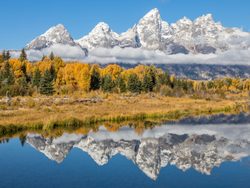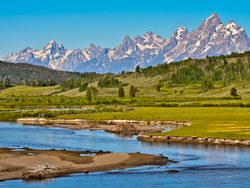
Grand Teton National Park
Quick Navigation
Grand Teton National Park is located in the far northwestern region of Wyoming, United States. The park is just south 10 miles (16 km) of Yellowstone National Park. The park covers an area of 480 square miles (1,300 sq km).
The heart of the park rests in the 40-mile (64 km) long range of mountains. Portions of the Jackson Hole valley make up the rest of the park’s boundaries. This Teton range of mountains is one of the most perfect postcard-like displays of nature.
Grand Teton, Yellowstone, and the neighboring national forests work together to create one of the world’s largest mid-latitude temperate ecosystems. This is a 28,125 square mile (72,843 sq km) of protected natural habitats.
According to the National Parks Service, this is where extraordinary wildlife interacts with pristine lakes, bogs, and alpine terrain. The Snake River meanders along with the front range of the Tetons and sets up some of the splendid landscapes that often find their way into paintings, travel books, and other artistic expressions.
There are over 300 species of birds that keep the over 60 mammalian wildlife species company across the park. Some of the larger more exciting wildlife opportunities include black bear, grizzly bear, gray wolf, moose, bighorn sheep, bison, pronghorn, cougar, coyote, and lynx.
The smaller animals which are often intriguing to people include badger, beaver, porcupine, river otter, marmot, muskrat, and chipmunk. Some of the more popular bird species include the golden eagle, bald eagle, osprey, red-tailed hawk, peregrine falcon, and the great horned owl.
Highlights
The Tetons Range is one of the most picturesque collections of mountains in the world. These have served as the focal and backdrop of many stunning images and paintings. Standing along the road and looking out across the meandering river with the Tetons behind them is one of the most famous lookouts.
 Grand Teton
Grand Teton
Grand Teton is the tallest mountain in the Tetons Range. It reaches a summit of 13,775 feet (4,199m), which is approximately 850 feet (260 m) higher than Mount Owen which is the second tallest peak in the Tetons.
Jackson Lake
Jackson Lake is the largest lake in the park. The lake stretches 15-miles (24 km) in length, 7 miles (11 km) wide, and reaches a depth of 438 feet (134 m). The Snake River feeds into the lake from northern Wyoming. The lake has over 15 islands scattered across its area.
 Snake River
Snake River
Snake River traverses across the northwest 1,078 miles (1,735 km). It is the largest North American river that empties into the Pacific Ocean. It originates in Wyoming and is a pinnacle attraction of the park. One of the most photographed lookouts appears across the Snake River toward the Tetons.
John Moulton Barn
The John Moulton Barn is also known as the T.A. Moulton Barn. It is a historic barn located in the valley with the Tetons located as the backdrop. The estate was constructed between 1912 and 1945, and the barn is the only thing that remains. For those that one to add an element of culture or history into their nature photography, this is one of the most photographed barns. It is always fun to try and come up with unique perspectives.
Grand Teton National Park Trails
There Tetons have over 200 miles (320 km) of hiking trails with trails that range from easy to difficult providing something for everyone.
Grand Teton Highlights
- Teton Range
- Grand Teton
- Jackson Lake
- Snake River
- John Moulton Barn
Park Map
Sources
- All Trails, Best Trails in Grand Teton National Park, https://www.alltrails.com/parks/us/wyoming/grand-teton-national-park, retrieved June 2020.
- Britannica, Grand Teton National Park, https://www.britannica.com/place/Grand-Teton-National-Park, retrieved June 2020.
- Jackson Hole, Grand Teton National Park, https://www.jacksonholewy.com/national-parks/grand-teton-national-park/, retrieved June 2020.
- National Geographic, Complete National Parks of the United States, National Geographic Publishing, Washington DC.
- National Geographic, Guide to the National Parks of the United States, National Geographic Society, 2003.
- National Geographic, National Parks of North America, Canada-United States-Mexico, National Geographic Society, 1995.
- National Park Service, Grand Teton, https://www.nps.gov/grte/index.htm, retrieved June 2020.
- Recreation.gov, Grand Teton National Park, https://www.recreation.gov/camping/gateways/13525, retrieved June 2020.
- US News, Grand Teton National Park Travel Guide, https://travel.usnews.com/Grand_Teton_National_Park_WY/, retrieved June 2020.


























